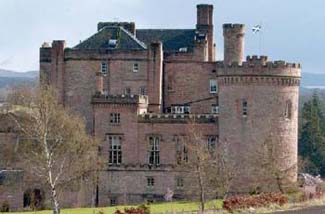
Photos courtesy of Dalhousie Castle
Bonnyrigg, Edinburgh
EH19 3JB
Tel: ++44 (0)1875 820153
Fax: ++44 (0)1875 821936
Hotel website
Reserve with Booking.com
27 rooms, including 14 themed rooms and 7 rooms in lodge on grounds
Castle:
Double rooms: £79–400
Rates include breakfast and
VAT
Discounts for early booking
Open: all year
Bonnyrigg is just outside of Edinburgh. Take A7 south through Lasswade and Newtongrange. Turn right on B704. The castle is 1/2 mile farther on the left. However, to reach it, turn right and go back under the road bridge.
On site: archery; falconry;
clay pigeon shooting
Nearby: fishing; horseback
riding; golf
Yes. Private chapel available. Inquire hotel for details.
If you were a castle guest here in medieval times, you would have crossed a drawbridge over a deep moat to reach the front door. If you had no invitation in hand, the residents might have poured burning oil on you from an opening in an overhead parapet or lowered you by ropes into a ten-foot-square windowless dungeon. All features that can be seen today.
Hospitality to the wayfarer at Dalhousie has changed considerably. Completely restored, the castle is an elegant and charming hotel.
An Imperial staircase, built around 1840 to resemble a ships quarter-deck, leads upstairs from the entrance hall. A magnificent oak-paneled library with a molded ceiling makes a fine place to relax with a book in front of a blazing fire. Guests gather here for a pre-dinner drink from the “secret bar” hidden behind a false bookcase door, and to gaze out the window at the river Esk.
Several guest rooms carry historical themes. In the castle tower, the Dalhousie Suite features a 16th-century-style reproduction four-poster bed and oak furniture, a private corridor decorated with miniature tapestries leads to an antique-decorated bathroom. The Sir William Wallace Suite blends the castles natural stone with Gothic-style fittings; oak paneling and tiles with the Wallace crest line its bathroom. The India Suite, named in honor of the young Dalhousie who became a governor-general of India, has a canopy bed and furniture copied from the period of the Raj. “Ordinary” rooms feature twelve-foot-high ceilings and tall windows framed with heavy brocade drapes.
The ancient barrel-vaulted dungeon serves as an unusual (and highly regarded) restaurant with candlelight dining. Local game and fish feature prominently on the menu.
![]() Ghost tours
Ghost tours